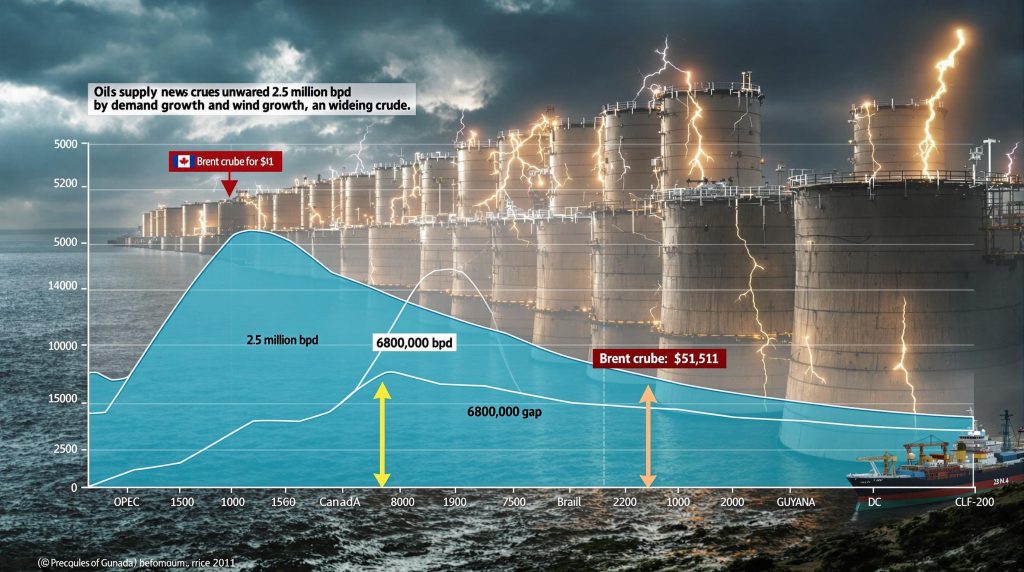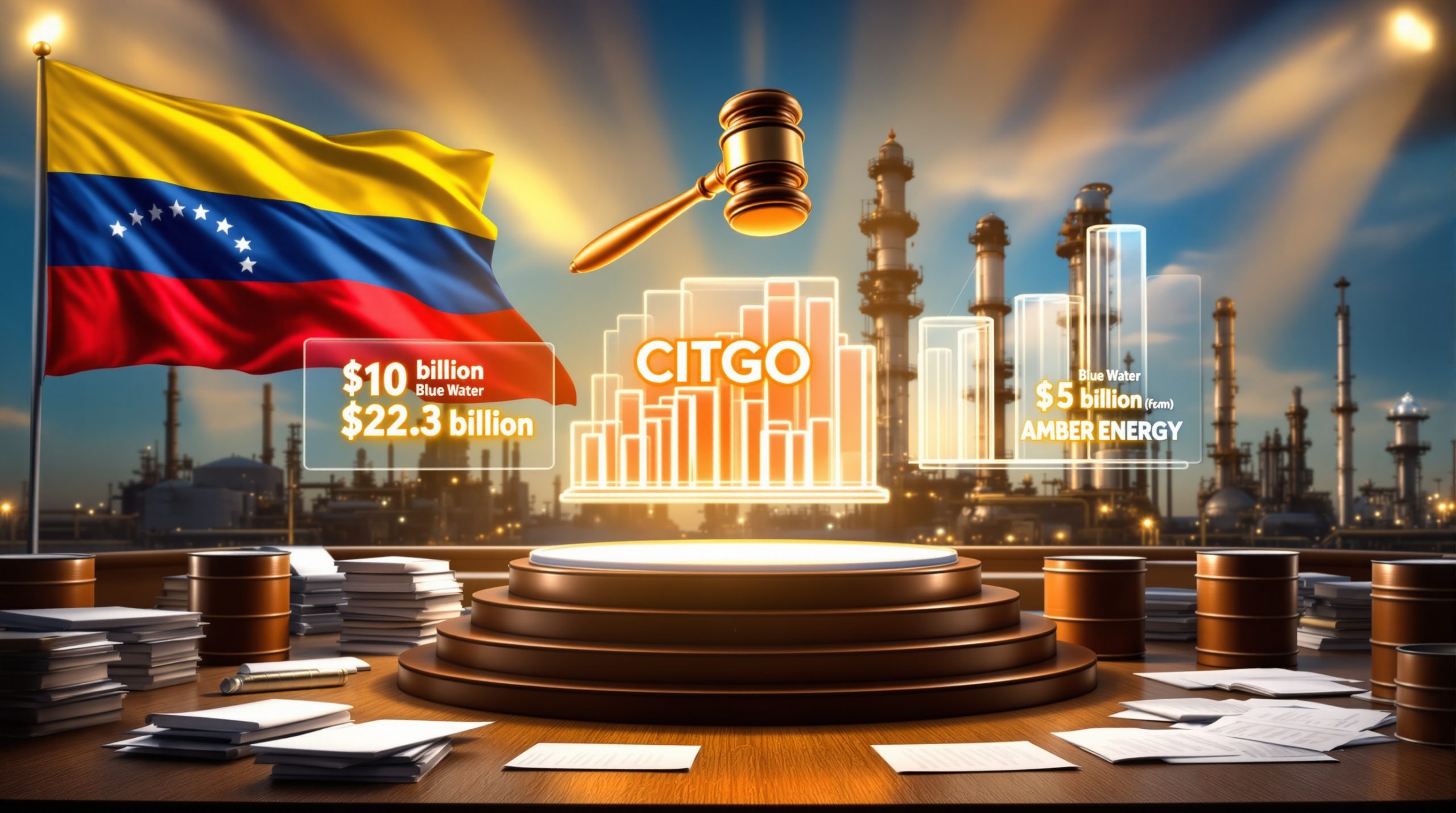How Will the Record Supply Surge Impact Oil Stockpiles in 2025-2026?
The global oil market is poised for a significant transformation as supply growth rapidly outpaces demand, potentially leading to the largest inventory buildup since the pandemic. With projections showing record-breaking stockpile accumulations in late 2025 and early 2026, industry participants and observers are closely monitoring these developments and their potential implications for pricing, production strategies, and market dynamics.
What is causing the oil market's supply-demand imbalance?
Unprecedented supply growth outpacing demand
Global oil supply is set to surge at a record pace in late 2025 and early 2026, creating what could become the largest inventory buildup since the pandemic. According to the International Energy Agency's (IEA) August 2025 Oil Market Report, global oil supply growth has been revised upward by 370,000 barrels per day (bpd) to a massive 2.5 million bpd in 2025. This substantial increase significantly outpaces demand growth, which is projected at a mere 680,000 bpd for the same period.
The IEA has been consistently bearish on oil demand, stating that "oil market balances look ever more bloated as forecast supply far eclipses demand towards year-end and in 2026." This widening gap between supply and consumption is setting the stage for a substantial market imbalance that could reshape pricing dynamics and trading strategies across the industry.
OPEC+ production increases
The OPEC market influence has shifted as the alliance has accelerated the unwinding of their production cuts, with eight member countries agreeing to boost output by 547,000 bpd in September 2025. This decision completes the reversal of the 2.2 million bpd cuts that were implemented in November 2023. The group's shift toward increased production comes at a time when market fundamentals are already weakening.
This strategic pivot marks a significant change from the alliance's previous cautious approach to market management. The timing of these production increases coincides with falling prices and weakening demand, suggesting OPEC+ members may be prioritizing market share over price support—a notable shift in their traditional market approach.
Non-OPEC+ producers driving growth
The most significant supply increases are coming from producers outside the OPEC+ alliance. Non-OPEC+ countries are projected to add 1.3 million bpd in 2025 and another 1 million bpd in 2026. According to the IEA's latest Oil Market Report, this growth is "bolstered by rising output of US NGLs, Canadian crude and US, Brazilian and Guyanese offshore oil."
This diversification of supply sources reduces OPEC+'s market influence and creates a more complex competitive landscape. Technological advancements in drilling and extraction, particularly in offshore environments, have enabled previously marginal resources to become economically viable, contributing to this persistent supply growth despite price pressures.
Why is oil demand growth disappointing?
Persistent economic challenges
Consumer confidence remains depressed across major economies, limiting the potential for significant demand recovery. The IEA notes that "the latest data show lackluster demand across the major economies and, with consumer confidence still depressed, a sharp rebound appears remote." This economic uncertainty has led the agency to downgrade oil demand growth expectations in six out of eight monthly reports in 2025.
Since the beginning of 2025, the IEA has slashed its oil demand growth projection by a combined 350,000 bpd, reflecting the persistent weakness in global economic conditions. Manufacturing activity in several key economies remains subdued, reducing industrial oil consumption and creating additional headwinds for demand growth.
Weaker consumption in emerging markets
Contrary to earlier projections, emerging and developing economies are showing unexpectedly weak demand. The IEA reports that "consumption in emerging and developing economies has been weaker than expected, with China, Brazil, Egypt and India all revised down compared with last month's Report."
This underperformance is particularly concerning as these markets were expected to drive global oil demand growth. China's transition toward more service-oriented and less energy-intensive economic growth has resulted in lower oil consumption than anticipated. Meanwhile, economic challenges and US inflation and tariffs have dampened oil demand in these traditionally high-growth markets.
Mixed transportation fuel trends
While aviation fuel demand has shown strength, with consumption in the United States and Europe increasing by more than 2% this year, this bright spot hasn't been enough to offset weakness in other transportation sectors. The summer travel season provided temporary support, but broader transportation fuel demand remains sluggish.
Several factors are constraining transportation fuel consumption growth, including the accelerating transition to electric vehicles, improved fuel efficiency in conventional vehicles, and changing mobility patterns. Remote work arrangements have permanently altered commuting habits in many regions, creating a structural shift in gasoline demand that appears likely to persist.
What will happen to global oil inventories?
Record inventory builds expected
The supply-demand imbalance is projected to result in unprecedented inventory accumulation. According to Ole Hansen, Head of Commodity Strategy at Saxo Bank, the world faces "a record supply glut next year with oil inventories accumulating at a rate of 2.96 million bpd, surpassing even the average buildup during the pandemic year of 2020."
This massive surplus represents a fundamental shift in market dynamics. During the pandemic, inventory builds were driven by demand destruction, but the current situation stems from supply growth outpacing moderate demand. This distinction is critical for understanding how the market might react and adjust to these changing conditions.
Current inventory trends
The inventory buildup has already begun, with global observed oil stocks increasing by 1.5 million bpd in the second quarter of 2025. This accumulation has been particularly pronounced in certain regions, with Chinese crude inventories rising by 900,000 bpd and U.S. gas liquids stocks increasing by 900,000 bpd during the same period.
These early signs of inventory accumulation indicate that the projected record supply surge sets stage for oil stockpile blowout is already materializing. The speed and scale of these builds suggest that storage capacity could become a significant factor in pricing dynamics if the trend continues, potentially leading to widening contango in futures markets as traders price in storage costs.
Regional stockpile distribution
While global inventories are rising, the distribution remains uneven. The IEA notes that stocks at pricing hubs remain well below historical averages despite global inventory builds. These strategic storage hubs and pricing centers currently show tighter balances than the overall market, which has helped support prices despite the building surplus.
This regional imbalance creates both challenges and opportunities. Traders with access to storage in key hubs may benefit from location-based arbitrage opportunities. However, as these key locations begin to fill, price support will likely erode, potentially triggering more rapid price declines once capacity constraints become apparent.
How are oil price forecasts changing?
Downward revisions for 2026
Price forecasts for 2026 have been significantly reduced as the supply glut scenario becomes more likely. The U.S. Energy Information Administration (EIA) has cut its Brent crude price projection to an average of $51 per barrel for 2026, down from $58 per barrel in its previous outlook. This 12% reduction reflects growing concerns about oversupply.
The EIA also predicts that global oil inventory builds will average more than 2 million bpd in Q4 2025 and Q1 2026, which is 0.8 million bpd more than their previous month's forecast. This substantial revision indicates how quickly market expectations are shifting as new supply and demand data emerges.
Short-term price resilience factors
Despite the bearish outlook, several factors have helped maintain price levels in the near term. The IEA highlights that record refinery runs during the summer helped absorb additional supply, while below-average inventories at key pricing hubs have provided temporary price support.
Additional factors sustaining current prices include geopolitical risk premiums and potential supply disruptions from sanctions on Iran and Russia. However, these supporting elements may prove insufficient to counterbalance the fundamental oversupply situation as it intensifies in late 2025 and early 2026.
Market structure signals
The oil futures market structure is beginning to reflect concerns about future oversupply. The contango pattern (where future prices are higher than current prices) is widening, indicating that traders are pricing in the expected inventory builds and anticipating lower spot prices in the coming months.
This evolving market structure creates strategic implications for various market participants. Physical traders with storage access may implement contango plays, while producers might accelerate hedging programs to lock in higher current prices. Meanwhile, consumers may delay long-term purchasing commitments in anticipation of better pricing opportunities ahead.
Why do OPEC and the IEA have such different outlooks?
Fundamental forecast disagreements
The International Energy Agency (IEA) and OPEC maintain starkly different views on the oil market's future. Their forecasts diverge significantly on several key metrics:
| Metric | IEA Forecast | OPEC Forecast |
|---|---|---|
| 2025 Demand Growth | 680,000 bpd | 1.29 million bpd |
| 2026 Demand Growth | 700,000 bpd | 1.4 million bpd (implied) |
| 2026 Total Demand | 104.4 million bpd | 106.52 million bpd |
| Non-OPEC+ Supply Growth (2025) | 1.3 million bpd | 800,000 bpd |
| Non-OPEC+ Supply Growth (2026) | 1 million bpd | 600,000 bpd |
These stark differences highlight the extraordinary uncertainty surrounding market forecasts and the strategic considerations that influence institutional outlooks. The 2.12 million bpd gap between OPEC and IEA's 2026 demand projections represents more than 2% of global consumption—a margin that would dramatically alter market balances.
Differing views on economic recovery
OPEC maintains a more optimistic outlook on global economic growth, particularly in key oil-consuming regions. The organization expects stronger economies to drive higher oil consumption, while the IEA sees persistent economic challenges limiting demand growth potential.
These divergent views stem from different methodological approaches and institutional objectives. As a producer organization, OPEC has strategic reasons to project robust demand growth, while the IEA's consumer-oriented perspective may lead to more conservative consumption estimates. Both organizations utilize similar data sources but apply different weightings and interpretations to economic indicators.
Supply growth projections
The organizations also differ significantly in their assessment of non-OPEC+ production growth. The IEA projects much stronger output increases from countries outside the alliance, particularly from North and South American producers. OPEC's more conservative supply growth estimates contribute to its tighter market outlook.
These disparities reflect fundamental disagreements about production economics, decline rates in mature basins, and the likely pace of new project development. The IEA generally assumes greater technological efficiency and faster project execution in non-OPEC regions, while OPEC typically projects more conservative capacity growth and higher decline rates in mature fields.
What are the potential market impacts of the coming glut?
Price pressure scenarios
If inventory builds materialize as projected, oil prices could face significant downward pressure. The EIA has already reduced its 2026 price forecast substantially, and further revisions may follow as the supply-demand imbalance intensifies.
Market analysts have outlined several potential price scenarios:
- Moderate decline: Prices gradually move lower as inventories build, with Brent potentially settling in the $45-55 range throughout much of 2026
- Sharp correction: A sudden market repricing once key storage hubs begin to fill, potentially pushing prices temporarily below $40
- Volatility increase: Larger price swings as traders react to changing fundamentals and policy responses from major producers
Each scenario carries different implications for market participants, from producers adjusting investment plans to consumers recalibrating purchasing strategies.
Producer responses
Low oil prices in early 2026 will likely trigger production adjustments from both OPEC+ and non-OPEC producers. According to the EIA, "Low oil prices in early 2026 will lead to a reduction in supply by both OPEC+ and some non-OPEC producers, which we expect will help moderate inventory builds later in 2026."
This natural market balancing mechanism may take time to materialize, as many producers will initially attempt to maintain output levels to support cash flow. Higher-cost production will be most vulnerable to curtailment, with North American shale, deep offshore projects, and technically challenging developments facing the greatest pressure to reduce activity.
Regional production shifts
The market imbalance is expected to alter regional production dynamics. In 2026, Brazil is projected to lead annual production growth among non-OPEC+ producers with an increase of 160,000 bpd, surpassing the United States, which is expected to add 130,000 bpd. This marks a significant shift from recent years when U.S. production dominated growth.
This changing landscape reflects Brazil's long-term offshore investment cycle, which is less responsive to short-term price fluctuations than U.S. shale production. The relative resilience of Brazilian output compared to more price-sensitive U.S. shale production illustrates how the market's center of gravity continues to evolve, with implications for trade war oil movements and infrastructure requirements.
What factors could change the market outlook?
Geopolitical disruptions
Potential supply disruptions remain a key uncertainty. Sanctions on Iran and Russia could constrain production from these major exporters, potentially offsetting some of the projected surplus. Any escalation in Middle East tensions or changes to sanctions policies could significantly alter the supply picture.
The market tends to underestimate the probability and impact of geopolitical disruptions during periods of oversupply. However, history shows that supply interruptions often occur unexpectedly, quickly transforming market sentiment from bearish to bullish. Maritime chokepoints, particularly the Strait of Hormuz, remain vulnerable to disruption, with approximately 20% of global oil flows passing through this narrow waterway.
Economic performance surprises
A stronger-than-expected global economic recovery could boost oil demand beyond current projections. Conversely, economic deterioration could further weaken consumption, exacerbating the oversupply situation.
Central banks' monetary policies will play a crucial role in determining economic trajectories. If inflation pressures subside more rapidly than anticipated, allowing for monetary easing, consumer spending and industrial activity could accelerate, boosting oil demand. Alternatively, persistent inflation might force continued restrictive policies, further constraining economic growth and oil consumption.
OPEC+ policy adjustments
The OPEC+ alliance could respond to falling prices by implementing new production cuts. The group has demonstrated willingness to adjust output to support market stability, though coordination challenges may increase if prices fall significantly.
Internal OPEC+ dynamics have grown more complex in recent years, with divergent interests emerging among key members. Russia's fiscal needs and market priorities increasingly differ from those of Saudi Arabia and other Gulf producers. These internal tensions could complicate collective decision-making if market conditions deteriorate rapidly, potentially delaying or limiting the scale of production adjustments.
How might different market segments be affected?
Refining sector challenges
Refiners may face margin pressure as crude oversupply coincides with product market weakness. Chinese refiners are already experiencing deepening losses due to overcapacity and weak domestic demand, a situation that could spread to other regions as the global surplus grows.
Refineries with less complex configurations and higher operating costs will be most vulnerable in this environment. Meanwhile, facilities with advanced conversion capabilities, operational flexibility, and advantaged locations may maintain better margins. The anticipated margin compression will likely accelerate refinery rationalization, particularly in developed markets with aging infrastructure and declining local demand.
Storage sector opportunities
Companies with storage capacity may benefit from the widening contango market structure. As inventories build, demand for storage facilities typically increases, potentially boosting revenues for terminal operators and storage-focused businesses.
Strategic storage locations that influence benchmark pricing will command premium rates. Floating storage economics may also become favorable if the contango structure steepens sufficiently to cover chartering costs. Companies with integrated trading and storage operations will be particularly well-positioned to capitalize on the evolving market structure through time arbitrage strategies.
Transportation and logistics shifts
Changing trade patterns may emerge as the market rebalances. With Brazil expected to lead production growth among non-OPEC+ producers in 2026, shipping routes and logistics networks may need to adapt to new supply sources and destinations.
Vessel demand patterns will evolve accordingly, potentially altering freight rates on key routes. Infrastructure constraints in emerging production regions could create bottlenecks and quality segregation challenges. Meanwhile, shifting refinery utilization patterns may redirect product flows, creating both constraints and opportunities for midstream operators and transportation companies.
Frequently Asked Questions About the Oil Market Outlook
Will OPEC+ implement new production cuts if prices fall?
OPEC+ has historically responded to price weakness with production adjustments. However, the alliance faces growing internal challenges, with some members seeking to maximize revenue through volume rather than price. The group's willingness and ability to implement new cuts will depend on the severity of price declines and internal cohesion.
Saudi Arabia, as the alliance's de facto leader, maintains significant spare capacity that could be withdrawn if necessary. However, securing full compliance from all members becomes increasingly difficult in low-price environments, as fiscal pressures mount on oil-dependent economies. The threshold for action likely depends on both the absolute price level and the perceived duration of market weakness.
How might U.S. production respond to lower prices?
Seeking Better Returns in Volatile Oil Markets?
Discover timely investment opportunities within the mining and resource sector with Discovery Alert's proprietary Discovery IQ model, providing real-time alerts on significant ASX mineral discoveries that offer potential market-beating returns. Explore historic examples of exceptional investment outcomes by visiting our dedicated discoveries page and position yourself ahead of the market.




